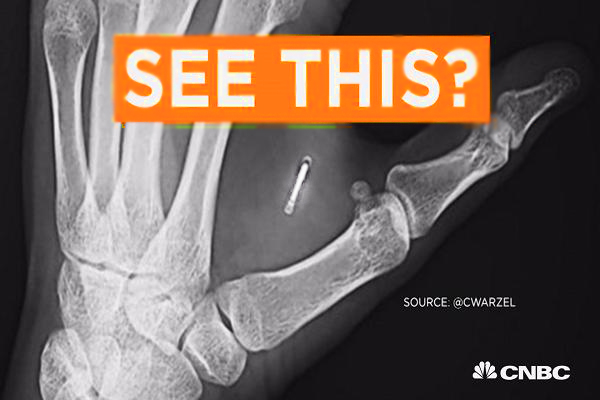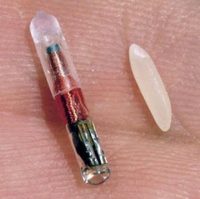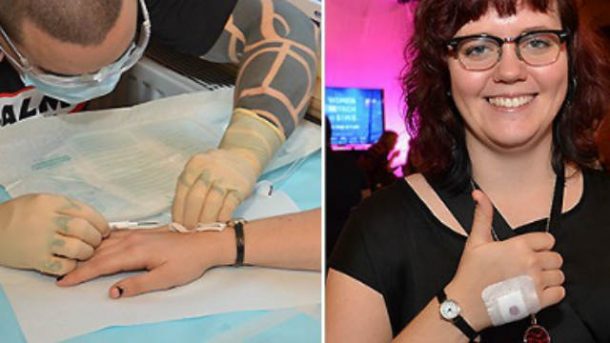
Patrick Henningsen
21st Century Wire
British futurist Aldous Huxley wrote his literary classic Brave New World in 1931, and in less than one hundred years western society has already realized his dystopian vision.
Back in 2010, I wrote a piece entitled, The 21st Century Matrix: Technocracy and the Rise of the Machines, where I talked about the nature of technology and its rapid advance, and posited the question: So how does one make sense of this 21st century matrix? Back then, like many other researchers, I was focusing on robotics as one of the primary areas of concern regarding trends in social engineering and ethics. While the emerging field of robotics and Artificial Intelligence (AI) continues to occupy a prominent position in discussion forums, other important areas like Radio-frequency Identification (RFID) technology and networked ‘middleman’ applications are receiving relatively little attention.
Beyond the obvious implications of an emerging cashless society, there are other inherent risks to consider…
That said, my previous question appears to have been superseded by another: If we come fully integrated with our machines, will we be able to decouple from that matrix? Welcome to the brave new world of implantable microchips.
 This week we learned that a Wisconsin company called Three Square Market (aka ’32M’) is planning to offer its staff implantable microchips. The idea is that these chips will allow workers to perform routine tasks like opening doors, using copy machines and purchasing snacks at company vending points.
This week we learned that a Wisconsin company called Three Square Market (aka ’32M’) is planning to offer its staff implantable microchips. The idea is that these chips will allow workers to perform routine tasks like opening doors, using copy machines and purchasing snacks at company vending points.
A new driver of this implant technology is a Swedish corporation called Biohax International. They are offering what is described as a “passive device,” more or less the same technology that is used for contactless ‘smart’ travel cards and bank cards, and for microchips implanted in domestic pets. Presently, the chips contain a very small amount of data on them, but act as a key to enable devices and potential network gateways.
The name Biohax is a derivative of the trendy new term, “biohacking” which might sound like it has a negative connotation, but is used by the new technophile intelligensia as a cool way to promote chip implants and RFID tattoos also known as ‘wearables’ (see DARPA and the Silicon Valley’s highly disturbing Beast Tech segment). Naturally, this is where the transhumanist movement will gleefully chime in, extolling the virtues of binding man and machine into a new improved form for the ages.
While we’ve seen recent programs like this before, what’s interesting about this particular case is that the company in question 32M, will also be encouraging its employees to use the RFID implant in order to log into their computers. Where previously our mobile devices were viewed as an augmented accessory, and external to our person, this latest nudging exercise moves to fully integrate our person into this responsive data loop (Note: Wisconsin has recently passed legislation against forcibly implanting humans with RFID implants).
Concerns should not end there however. There are some very real physical health ramifications to consider…
The implant in the employee’s hand uses a technology known as Near Field Communication (NFC), which uses a ‘passive chip’ running off 13.56MHz – the same as contactless payment cards, new passports, or the Oyster card used on the London Underground. The active reader (emitting 13.56MHz) wakes up the passive chip at a range of 1-10meters. Potentially, it can also offer a low-speed connection with simple setup that can be used to bootstrap more capable wireless connections. It’s even being installed in a new line of trendy jewelery.
Leading UK advocate on RFID safety, Pippa King, explains the obvious problem and poses a key question. “This health warning from RFID Journal on proximity to RFID readers, this applies to 13.56mhz NFC also,” says King. “Given that we extend our limbs holding passive cards, or chipped hands, to readers how can we stay 1 meter away from a reader?” (See King’s report)
While manufacturers claim that the RFID chip implants – the size of a grain of rice – are supposedly ‘biologically safe,’ long-term effects are not at all known. Despite systematic corporate obfuscation on the issue, a number of studies have uncovered evidence which suggests that microchipping pets caused tumours in the area of the chip – the exact same tech as the NFC is the industry standard. This safety concern was first reported in the Washington Post in 2007, outlining a FDA study which clearly delineated the proven health risks involved with chip implants:
When the U.S. Food and Drug Administration approved implanting microchips in humans, the manufacturer said it would save lives, letting doctors scan the tiny transponders to access patients’ medical records almost instantly. The FDA found “reasonable assurance” the device was safe, and a sub-agency even called it one of 2005’s top “innovative technologies.” But neither the company nor the regulators publicly mentioned this: A series of veterinary and toxicology studies, dating to the mid-1990s, stated that chip implants had “induced” malignant tumors in some lab mice and rats.
“The transponders were the cause of the tumors,” said Keith Johnson, a retired toxicologic pathologist, explaining in a phone interview the findings of a 1996 study he led at the Dow Chemical Co. in Midland, Mich. Leading cancer specialists reviewed the research for The Associated Press and, while cautioning that animal test results do not necessarily apply to humans, said the findings troubled them. Some said they would not allow family members to receive implants, and all urged further research before the glass-encased transponders are widely implanted in people.
Regardless, the FDA went ahead to approve chip implants by then industry leader VeriChip Corp (since renamed PositiveID, owned by parent company Applied Digital Solutions based in Delray Beach, Fla.). When asked at the time about the damning risk assessment, VeriChip issued a predictable corporate denial:
The company was “not aware of any studies that have resulted in malignant tumors in laboratory rats, mice and certainly not dogs or cats,” but he added that millions of domestic pets have been implanted with microchips, without reports of significant problems.
“We stand by our implantable products which have been approved by the FDA and/or other U.S. regulatory authorities,” Scott Silverman, VeriChip Corp. chairman and chief executive officer, said in a written response to AP questions.
The government regulator side was not much better. Many asked at the time: did the FDA know of the tumor findings before approving the RFID implants? According to The Post’s Todd Lewan:
“The FDA declined repeated AP requests to specify what studies it reviewed.”
What about the American Medical Association (AMA), an important advisory body to the US federal government who, at the time was happily promoting the benefits of RFID implants? Had any of its ethics committee members reviewed available evidence regarding tumours in chipped animals?
No, said Dr. Steven Stack, an AMA board member with knowledge of the committee’s review. Was the AMA aware of the studies? No, he said.
The above demonstrated how the regulatory system really works in the United States, where risks are marginalized by corporate information laundering, or simply by naked omission of the facts.
In October 2010, Andrea Rutherford, owner of a mixed breed cat, filed a lawsuit against Merck & Co., and Digital Angel. The cat’s name was Bulkin, and when asked, the presiding veterinarian confirmed in the pet’s medical records: “The microchip was found at the center of the mass.” The verdict: Fibrosarcoma, “likely from microchip.” (See more information on cancer medical findings here).
Then there’s the social aspect. To make all this go smoothly, a degree of social engineering is required. According to online tech journal The Verge, “The vending kiosk company, also known as 32M, will “chip” employees at a party on August 1st. (According to an email to The Verge, chips and salsa will be served as snacks.) Around 50 people are supposedly getting the optional implants.”
 Back in 2014, Emilott Lantz, 25, from Umeå became Sweden’s first RFID guinea pig (Image Source: Midnight in the Desert)
Back in 2014, Emilott Lantz, 25, from Umeå became Sweden’s first RFID guinea pig (Image Source: Midnight in the Desert)
Recently, we also learned about a Swedish high-tech startup hub called Epicenter who is offering tiny microchip implants to workers, again to replace the use of swipe cards, used to open doors, operate copiers and printers, and to purchase lunch and snacks in the corporate cafeteria. To relieve them of these burdensome and difficult tasks, all they have to do is simply wave the hand over the RFID reader port.
Once again, the Swedish tech supplier Biohax is there to administer the implant. Here, self-described “body hacker” Jowan Osterlund does the “operation” using a preloaded syringe, before injecting the chip into the person’s hand.
“The syringe slides in between the thumb and index finger. Then, with a click, a microchip is injected in the employee’s hand. Another “cyborg” is created.”
As a result, more than 150 employees at Epicenter have opted for the RFID implant in order to better “streamlines office life.” Watch how Epicenter has gone out of its way to try to make the operation sexy and fun for willing “cyborgs”:
“The injections have become so popular that workers at Epicenter hold parties for those willing to get implanted.”

Sweden seems to be on the cutting edge of this latest wave of corporate transhumanism. Last month saw the roll-out of chip implants for commuters on trains, as Swedish travel firm SJ became the first in the world to offer an NFC enabled RFID implant to passengers, which the media are calling a “innovative method that seems straight out of a sci-fi film.” This is how The Independent marketed the announcement:
“Gone are the days when an e-ticket was seen as cutting edge – one Swedish rail company is offering passengers the option of using a biometric chip implanted into their hand in lieu of a paper train ticket.”
“State-owned operator SJ has said it expects about 200 people to take up the microchip method, but users must be signed up as a loyalty programme member to access the service. Customers buy tickets in the normal way by logging onto the website or mobile app, and their membership number, which is the reference code for the ticket, is linked to their chip.”
How cool. And you accrue loyalty points you may one day use to redeem a few pennies against your over-priced fares and on-board snacks. Or worse – those of us without the new state-issued implants will be forced to pay higher fares to cover costly old fashion administration. Just imagine the privileges one might enjoy by accepting the chip; super-peak deals, reserved seating, high speed WiFi, and maybe a complimentary seat in business class. What about a free Swedish shoulder massage? Sounds tempting.
In this 2015 Business Insider article entitled, Here’s why the strange practice of body hacking is taking off, the author appears to be going out of her way to make this practice of body hacking sound more than just fashionable, but desirable too.
What’s interesting is that in 2017, this concept is now being pushed heavily throughout the international mainstream media – which probably indicates that a number of technology companies are now ready to move their product to market and so require a global public relations push in order to acclimatize the public to the idea of implants. But don’t be fooled – much of this coverage appears to be packaged as regular ‘news’ reports, but is more likely paid for corporate placements, or what’s referred to in the industry using the rather Orwellian term,”Native Advertising.”
Watch as Buzzfeed reporter implants payments chip in hand from CNBC:
.
Some the mainstream media news reports, especially in the US, are simply breathtaking in their banality, and somewhat manipulative in the way they frame the adoption of this technology.
Watch this surreal ‘news’ report pushed out through ABC News…
Hacking Your Life
Aside from potential health risks, these chips can be hacked. According to Ben Libberton, a microbiologist at Stockholm’s Karolinska Institute who spoke with CNBC:
“Conceptually you could get data about your health, you could get data about your whereabouts, how often you’re working, how long you’re working, if you’re taking toilet breaks and things like that.”
Just how vulnerable is RFID technology to hacking? It’s remarkably easy to do. The security-prone chip technology have spawned a whole new cottage industry, both on the criminal side, as well as the corresponding security side.
As we have already demonstrated, selling this technology to the millennial generation will require the creation and promotion of a digital cyber culture, which includes group rituals and rights of passage ceremonies – which is not unlike a religion, or even a cult. It works like this:
Sandra Haglof, 25, who works for Eventomatic, an events company that works with Epicenter, has had three piercings before, and her left hand barely shakes as Osterlund injects the small chip.
“I want to be part of the future,” she laughs.
Making young people feel like they are ‘part of something’ – while simultaneously severing their common connection to a reality-based culture, their human heritage, including morals, ethics, and traditional community and family structures – all pushed aside in favour of a cheap, transient techno-gadget fix which supposedly represents the future. If that sounds like a traditionalist polemic, that’s because it is. And I believe that it’s a very important polemic, one for a generation that seldom pauses more than a few seconds to ponder anything that exceeds 140 characters, a ‘like’ and a few emojis.
What’s clearer than ever, is that corporations are more than willing to deploy stylish marketing roll-outs in order to shroud genuine health concerns over their fashionable new “biohacking” hardware app.
Welcome to the brave new world. Corporate marketeers and privatized social engineers are turning us into pseudo individual units, defined by what we consume, and which routines we conform to as part of the New Digital Collective.
It’s more than just biohacking, it’s hacking humanity.
***
Patrick Henningsen is an American-born writer and global affairs analyst and founder of independent news and analysis site 21st Century Wire and host of the SUNDAY WIRE weekly radio show broadcast globally over the Alternate Current Radio Network (ACR).
SEE ALSO: Amazon, Berkshire and JPMorgan Forming Healthcare Company Focused on ‘Innovation Not Profits’
READ MORE RFID NEWS AT: 21st Century Wire RFID Files
SUPPORT OUR WORK BY SUBSCRIBING & BECOMING A MEMBER @21WIRE.TV















